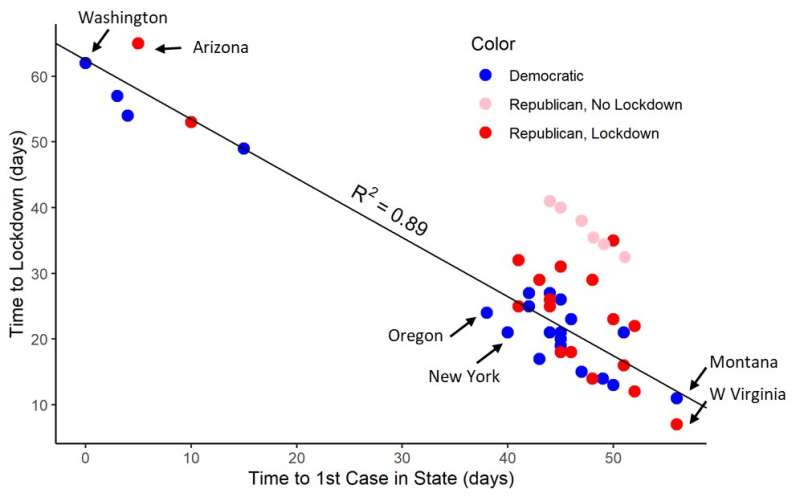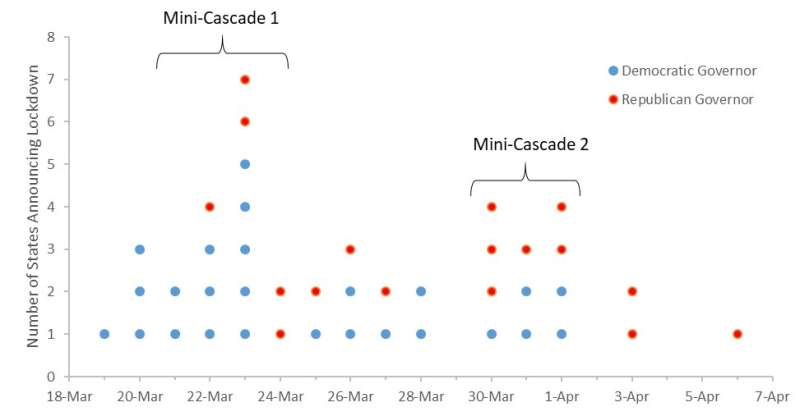What's driving governors' lockdown decisions?

As debate and protests about lockdowns and opening up flare up across the nation, experts are considering why governors decided to lockdown states in the first place.
A team of researchers from the USC Marshall School of Business, Medical College of Georgia at Augusta University and University of California, Riverside have examined the decision-making factors that led governors across the United States either to order lockdowns or to keep their states open amidst the threat of COVID-19. They had previously considered how long coronavirus quarantines could last based on empirical data on the severity of disease spread across states and countries. The authors' major finding is that governors were influenced more by behavioral theory of social learning, cascades, and political polarization, than by the science of disease penetration. The researchers are—Gerard Tellis of USC Marshall, Nitish Sood of Augusta University, and Ashish Sood of UC Riverside. The paper is available at the open source social science journal website. The trio's previous research on the duration of lockdowns for coronavirus is available here.
"It's striking how behavioral theories rather than disease science explain this vitally important decision for millions," said Tellis. "Our goal is merely to explain behavior, not to pass judgment."
Conventional wisdom would suggest that governors acted primarily on the percent of their state's population infected with COVID-19. Instead, the authors found and explained the four influences on governors' actions as follows.
- Political affiliation: A Democratic governor was three times more likely than a Republican governor to impose a lockdown;
- Social learning: Governors of states afflicted later by COVID-19 acted much faster than those who were afflicted early on, learning from the states afflicted before theirs;
- Mini-cascades: Actions of some governors sparked multiple other governors to order lockdowns in their states in the next three days, due to informational cascades;
- Disease Science: Counterintuitively, the percentage of the state's population infected with COVID-19, had the weakest effect on the governors' decisions of all the four variables.

"We started our inquiry with Dr. Anthony Fauci's poignant query of why states had not yet acted in ordering lockdowns to contain the spread of COVID-19," said Ashish Sood. "Using publicly available data, simple graphical analysis, and a formal hazard model, we find that states that acted did so for reasons other than the science behind infectious diseases."
Figure 1 below shows a plot of governors' decisions to order lockdowns over time. On the horizontal axis is days to the first case in the state from the first case in the US. On the vertical axis is the days from the first case in the state to lockdown. Each dot represents one state. The dark blue dots represent Democratic governors who acted as of the date of this study and the dark red represent Republican governors who acted. The light red represents the Republican governors who have yet to issue lockdowns as of the date of this study.
To investigate cascading effects further, researchers considered clusters of states deciding to lockdown within three days of each other. Two clusters were found wherein a number of states imposed lockdown in close temporal proximity. The first cluster likely started on March 22nd when Governor Cuomo announced a lockdown of New York, sparking lockdowns across 15 states in the next three days. The second cluster likely started on March 27th when Governor Walz and Governor Sununu announced lockdowns in Minnesota and New Hampshire respectively. Their decisions sparked lockdowns in eight more states within three days.
"It was astounding to see how much Governors learned from each other. States that were infected later locked down much quicker than states infected at the beginning of the pandemic" said Nitish Sood. "In addition, some states acted as catalysts, sparking lockdown decisions across many more states."
While inaction is understandable, according to the researchers, delay is not without costs in terms of probable infections, lost work days, hospitalizations, suffering, and death in the long term. At the same time, such delay may have saved businesses, jobs, and extreme inconvenience to citizens in the short term. How to estimate and compare those costs is the next project for the research group.
Provided by University of California - Riverside





















